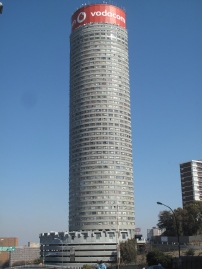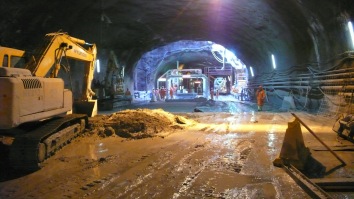Ponte City Building was built in 1975 and has been Africa’s tallest residential building for 40 years standing 173m high – a true engineering feat. However, it is due to lose its status soon – the Leonardo building currently under construction in Sandton is planned to be taller at 223m and is due for completion in 2017.

I decided to visit Ponte on a tour with Dlala Nje and learnt a lot about the history of the building. Dlala Nje is a non-profit company and profits from the tours are used to fund a creche on the ground floor of Ponte, as well as other programmes to benefit the community.
The 55-story building is cylindrical, with an open center allowing additional light into the apartments. The center space is known as “the core” and rises above an uneven rock floor.
When it was built, Ponte City was seen as an extremely desirable address for the affluent of Johannesburg due to its views over all of Johannesburg and its surroundings. It had over 400 apartments designed to house 3500 people. On the top floors were three-storey apartments. When Ponte opened, Hillbrow was designated a whites only area but people of all races inhabited the building and the government labelled it a “grey area” where whites and blacks could mix. However, Ponte became a “hijacked building” run by illegal landlords and the building the building which was meant to house 3500 people had over 10000 people living there. Government reacted by cutting off its power and removing policing from the area.
Even when apartheid came to an end in the early 1990’s, Ponte remained a dangerous building known for drugs and prostitution and crime and poverty. The middle core of the building was filled with a massive pile of rubbish almost a quarter of the way up the skyskraper and the apartments were in disrepair. Ponte was also known as Suicide City because of the number of people who jumped off the building both on the inside and outside. At the time, there were potential plans to turn the building into a prison in the sky.
In 2001, there were plans to reclaim Ponte. Illegal immigrants were evacuated, Trafalgar Properties took over management of the building and began making numerous improvements. Then in 2007 Ponte changed ownership and a re-development project New Ponte was put in motion. The planned development would have contained 467 residential units, retail and leisure-time areas. Over the next few years, the Johannesburg Development Agency planned to invest about R900-million in the areas around Ponte City such as the Ellis Park Precinct project, as well as an upgrade of Hillbrow and Berea partly in preparation for the 2010 Fifa World Cup. However, banks did not provide the funding required to finish the revitalisation, the project was cancelled and ownership was given back to the original owners, the Kempston Group.
More recently an afrikaans woman named Mrs Beetje took over running the building, which is still owned by Kempston Group. The residents call her Gogo, Zulu for “grandmother” because of the way she runs the building. Mrs Beetje use to work in the office of former apartheid president PW Botha. Today, almost all of the apartments have been refurbished and the security is tight – to get into the building you have to have your fingerprint registered. Any residents late with rent quickly get denied access to the building and have their possessions put outside.
Of the current 3,500 residents, about 10 percent are white. Mrs Beetje apparently does not like having students as residents because they are unreliable payers. The views from the top apartments are spectacular and rentals are between R2000 per month for an ordinary one bedroom mid-floor apartment to R6000 for a top floor two bedroom apartment.
The building itself, meanwhile, earns a fair amount of money on the side. Vodacom pays R500,000 a month to put its sign on the roof, (The neon sign on top of the building is the largest sign in the southern hemisphere), and movie producers pay R100,000 a day to shoot in the core (One of the final shots of the 2009 film District 9 is of the tower).
People I spoke to agree that there is still work to be done and Ponte tower is unlikely ever to regain its status as South Africa’s most palatial skyscraper. But with its modern flats and tight security, it’s turned a corner. Currently Ponte tower is fully occupied and there’s actually a waiting list to move in.”




















